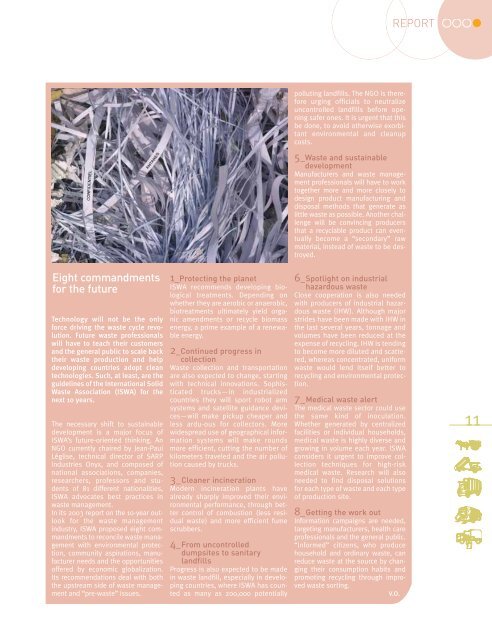What improves waste management? - Veolia Environmental Services
What improves waste management? - Veolia Environmental Services
What improves waste management? - Veolia Environmental Services
Create successful ePaper yourself
Turn your PDF publications into a flip-book with our unique Google optimized e-Paper software.
Eight commandments<br />
for the future<br />
Technology will not be the only<br />
force driving the <strong>waste</strong> cycle revolution.<br />
Future <strong>waste</strong> professionals<br />
will have to teach their customers<br />
and the general public to scale back<br />
their <strong>waste</strong> production and help<br />
developing countries adopt clean<br />
technologies. Such, at least, are the<br />
guidelines of the International Solid<br />
Waste Association (ISWA) for the<br />
next 10 years.<br />
The necessary shift to sustainable<br />
development is a major focus of<br />
ISWA’s future-oriented thinking. An<br />
NGO currently chaired by Jean-Paul<br />
Léglise, technical director of SARP<br />
Industries Onyx, and composed of<br />
national associations, companies,<br />
researchers, professors and students<br />
of 81 different nationalities,<br />
ISWA advocates best practices in<br />
<strong>waste</strong> <strong>management</strong>.<br />
In its 2003 report on the 10-year outlook<br />
for the <strong>waste</strong> <strong>management</strong><br />
industry, ISWA proposed eight commandments<br />
to reconcile <strong>waste</strong> <strong>management</strong><br />
with environmental protection,<br />
community aspirations, manufacturer<br />
needs and the opportunities<br />
offered by economic globalization.<br />
Its recommendations deal with both<br />
the upstream side of <strong>waste</strong> <strong>management</strong><br />
and “pre-<strong>waste</strong>” issues.<br />
1_Protecting the planet<br />
ISWA recommends developing biological<br />
treatments. Depending on<br />
whether they are aerobic or anaerobic,<br />
biotreatments ultimately yield organic<br />
amendments or recycle biomass<br />
energy, a prime example of a renewable<br />
energy.<br />
2_Continued progress in<br />
collection<br />
Waste collection and transportation<br />
are also expected to change, starting<br />
with technical innovations. Sophisticated<br />
trucks—in industrialized<br />
countries they will sport robot arm<br />
systems and satellite guidance devices—will<br />
make pickup cheaper and<br />
less ardu-ous for collectors. More<br />
widespread use of geographical information<br />
systems will make rounds<br />
more efficient, cutting the number of<br />
kilometers traveled and the air pollution<br />
caused by trucks.<br />
3_Cleaner incineration<br />
Modern incineration plants have<br />
already sharply improved their environmental<br />
performance, through better<br />
control of combustion (less residual<br />
<strong>waste</strong>) and more efficient fume<br />
scrubbers.<br />
4_From uncontrolled<br />
dumpsites to sanitary<br />
landfills<br />
Progress is also expected to be made<br />
in <strong>waste</strong> landfill, especially in developing<br />
countries, where ISWA has counted<br />
as many as 200,000 potentially<br />
polluting landfills. The NGO is therefore<br />
urging officials to neutralize<br />
uncontrolled landfills before opening<br />
safer ones. It is urgent that this<br />
be done, to avoid otherwise exorbitant<br />
environmental and cleanup<br />
costs.<br />
5_Waste and sustainable<br />
development<br />
Manufacturers and <strong>waste</strong> <strong>management</strong><br />
professionals will have to work<br />
together more and more closely to<br />
design product manufacturing and<br />
disposal methods that generate as<br />
little <strong>waste</strong> as possible. Another challenge<br />
will be convincing producers<br />
that a recyclable product can eventually<br />
become a “secondary” raw<br />
material, instead of <strong>waste</strong> to be destroyed.<br />
6_Spotlight on industrial<br />
hazardous <strong>waste</strong><br />
Close cooperation is also needed<br />
with producers of industrial hazardous<br />
<strong>waste</strong> (IHW). Although major<br />
strides have been made with IHW in<br />
the last several years, tonnage and<br />
volumes have been reduced at the<br />
expense of recycling. IHW is tending<br />
to become more diluted and scattered,<br />
whereas concentrated, uniform<br />
<strong>waste</strong> would lend itself better to<br />
recycling and environmental protection.<br />
7_Medical <strong>waste</strong> alert<br />
The medical <strong>waste</strong> sector could use<br />
the same kind of inoculation.<br />
Whether generated by centralized<br />
facilities or individual households,<br />
medical <strong>waste</strong> is highly diverse and<br />
growing in volume each year. ISWA<br />
considers it urgent to improve collection<br />
techniques for high-risk<br />
medical <strong>waste</strong>. Research will also<br />
needed to find disposal solutions<br />
for each type of <strong>waste</strong> and each type<br />
of production site.<br />
8_Getting the work out<br />
Information campaigns are needed,<br />
targeting manufacturers, health care<br />
professionals and the general public.<br />
“Informed” citizens, who produce<br />
household and ordinary <strong>waste</strong>, can<br />
reduce <strong>waste</strong> at the source by changing<br />
their consumption habits and<br />
promoting recycling through improved<br />
<strong>waste</strong> sorting.<br />
V.O.<br />
REPORT<br />
11



